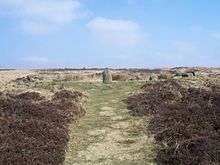Barbrook ring systems
The Barbrook ring systems, three stone circles (Barbrook I-III) and two Ring Cairns (Barbrook IV + V), are systems from the Bronze Age . They are located near Chatsworth House in Derbyshire , England .
The Embanked Stone Circles
Barbrook I-III are so-called "mounded stone circles " (eng. "Embanked Stone Circle"). In this type of stone circle, the only or the main circle lies within or on top of a low, round stone wall. The circles fall in the middle period (2670–1975 BC) according to Aubrey Burl (1926–2009). You get up, facing southwest to the River Bar Brook, from which the counties get their names, sloping terrain on the west side of Ramsley Moors. The Cairns Barbrook IV and V Ring are nearby.
Barbrook i
Barbrook I is the southernmost of the three typical Derbyshire small stone circles . The oval stone circle is 12 to 14 m in diameter and contained 12 or 13 stones, of which only the southwestern one is more than a meter high. This stone seems to form an entrance with its neighboring stone, but whether the disposition is original is unclear, because there is a large gap in the northeast, there could also have been the entrance. The "Embanked Stone Circle" is surrounded by the remains of a low wall that is 17 to 19 m in diameter.
The stone mound to the north of the stone circle was excavated and restored during the 1980s. Four stones with small bowls were found . One of them also has a ring . A row of stones and the remains of a field system lie between Barbrook I and II .
Coordinates: 53 ° 16 ′ 32.7 " N , 1 ° 35 ′ 6.2" W.
Barbrook II
Barbrook II, about 250 m away, is the middle of the three stone circles . The oval ring is contained, but not like other stone circles in Derbyshire. What distinguishes the circle is that the menhirs were set in the dry stone wall or in the wall of rubble. Today you can see the result of the restoration of 1989. The nine stones (there were probably 10 originally) are typical of the area. All are less than a meter high, with a larger stone to the west, similar to Barbrook I. The "Embanked Stone Circle" has a diameter of about 14 m. Its access is in the northeast. Inside the circle, on the west side, are the remains of a stone mound, next to which there is presumably the destroyed top plate of a stone box with three or four cups and a weakly pecked corner.
Coordinates: 53 ° 16'43.1 " N , 1 ° 35'7" W.
Barbrook III
Barbrook III, the third stone circle on Barbrook Moor, is also known as the "Owler Bar" and stands on the plateau in the northeast of the moor near a reservoir. The Bronze Age circle is almost hidden under tufts of grass in summer, because the tallest stone is a little more than half a meter high. Even so, it is one of the largest stone circles in Derbyshire. The somewhat oval ring made of 21 preserved stones lies within a barely recognizable wall, 26 m × 24 m in diameter. Victoria and Paul Morgan believe that there were three gaps in the wall and that the one in the northeast was the gateway.
Coordinates: 53 ° 17 ′ 30.6 " N , 1 ° 34 ′ 34.7" W.
The Ring Cairns
Barbrook IV
The Cairn Barbrook IV ring is on the other side of the A621 road in Ramsley Moor , separate from the other monuments . Barbrook IV is between 22 and 24 m in diameter. The low, approximately 3.5 m wide wall made of stone and earth is less than half a meter high and has an entrance in the southwest. There are a few smaller cairns nearby, all of which are likely part of the larger Bronze Age complex that lies here in the moor on either side of the A621.
Coordinates: 53 ° 16 ′ 36.7 ″ N , 1 ° 34 ′ 2.3 ″ W.
Barbrook v
There is little information and few remains, as the site on the edge of a packhorse path was damaged in the Middle Ages and only the south-eastern part of the ramparts and a few menhirs have been preserved, making it difficult to gauge the original size of the monument. It appears to be the same size as Barbrook IV, but with a narrower wall.
Coordinates: 53 ° 16 ′ 20.9 " N , 1 ° 35 ′ 58.4" W.
Individual evidence
- ↑ Ring Cairns are round or oval stone walls (without menhirs), with a free space in the middle, which in some cases was later filled in. Although burials have been found in some, this does not seem to have been the original purpose. They could be thought of as stone circles, as stone circles are rare in the area around the Ring Cairns in southeast Wales. The platform of the Cairns cannot always be seen without excavations.

